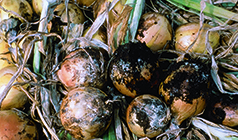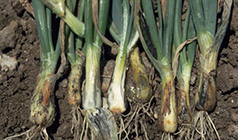White rot
White rot, caused by Sclerotium cepivorum Berk, is considered the most severe disease of alliums. It usually affects patches of plants, rather than individuals.
Onions | Onion pest and disease threats | Pest eradication or control examples

White rot, caused by Sclerotium cepivorum Berk, is considered the most severe disease of alliums. It usually affects patches of plants, rather than individuals.
It can be difficult to differentiate from other diseases above ground. White rot will cause stunted plant growth, followed by yellowing and death of the outer leaves.
Later, remaining leaves and the central stem dies, and there will be an obvious rotting of the stem above the bulb. In severe cases the bulb will be completely rotten.
Infected plants will pull easily from the soil. The disease presents as a fluffy white (mycelia) growth on the roots and root plate, with tiny black growths like poppy seeds (sclerotia).
The sclerotia are highly resistant to adverse temperatures and conditions, and can remain alive in the soil for thirty or more years, even in the absence of a host.
A small number of sclerotia can cause significant disease, and it is very difficult to control.
White rot was an exotic pest to Australia but was somehow introduced in the 1960s. The disease went unreported and, with few growers managing biosecurity risks on farm, it spread quickly.
The disease had a devastating impact on onion growers. Some onion growing areas were so badly affected by white rot that production ceased or was dramatically reduced. For example, in the late 1940s, 60,000 tonnes of what were said to be the best quality onions in Australia were produced in western Victoria around Colac and Port Fairy. Once white rot became established, soils in the region became so heavily infested that production of onions fell to less than 5,000 tonnes.
Onion growers still have to contend with white rot today. It has spread to all onion growing states except Western Australia, and strict movement controls are in place to maintain area freedom.
Options for the management of the fungal disease have been identified through research and development, but it still poses a threat to onion production.
As a soil fungal disease it can be spread on people, vehicles and machinery. It is difficult to control because it is a disease which survives in the soil for many years and the high disease pressure in many commercial fields cannot be managed by fungicides alone.
On-farm biosecurity measures will slow its spread into new areas.
The case of onion white rot demonstrates the importance of ongoing biosecurity measures on farms.
Growers should monitor crops and report anything unusual immediately on 1800 084 881.
Consistent use of farm biosecurity measures will keep this threat and others out of your property.

Onion smut (Urocystis cepulae) is a damaging fungal disease which weakens plants and causes seedling death.
Seedlings usually die within a few weeks. Those that survive are often distorted and remain stunted.
It can persist in soil for many years, making eradication difficult.
In 1979 the exotic pest onion smut was detected in South Australia. The detection sparked an eradication program that continued for almost four decades.
Australia is once again free from this disease, but ongoing surveillance is required to provide evidence that our produce is onion smut free.
The eradication program has been long and involved. The affected crops were destroyed, infected paddocks disinfected, equipment cleaned, and strict on-farm biosecurity measures were implemented. Then there was a long wait.
Fifteen years of quarantine was required to make sure that no spores remained in the soil, so no onions or other Allium crops could be grown for that period.
The South Australian government undertook annual inspections from 1979 until 2010 to ensure area freedom. On average, 111 properties per year were inspected – over 90 per cent of the South Australian onion industry – and crops checked included leeks, shallots, spring onions, garlic and chives. Growers were required to establish that their property was free from smut so that they could access interstate markets.
The cost for surveillance, approximately $50,000 per year, was recovered from growers. There were positive detections of onion smut during this time, each of which was dealt with by crop destruction, disinfection, tightened onfarm biosecurity measures and a long wait.
The disease was last detected in 2002, and quarantine restrictions ended in October 2017. The eradication program was long and expensive and highly stressful for affected growers, but it was effective and provided benefits for the entire industry. It relied on consistent use of on-farm biosecurity practices to prevent onion smut spreading further.
It could happen again. Onion smut is spread in contaminated soil: in this case shared harvest bins were linked to spread of the disease between growers and packing sheds.
To protect yourself from a future incursion make sure bins are free from contaminants or remove bins from your production system and harvest directly into trailers which are cleaned down between paddocks. Also maintain biosecurity practices around people, vehicle and equipment movements.
There is no evidence of transmission by seed, but the disease could be transferred as a contaminant on the seed coat or loose plant material in a consignment if the crop was grown in an infected area so seek clean seed certification where possible.